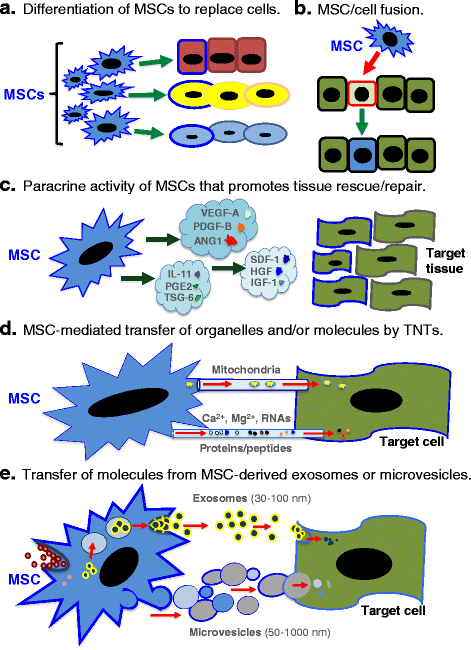Mechanisms of mesenchymal stem/stromal cell function
- PMID: 27581859
- PMCID: PMC5007684
- DOI: 10.1186/s13287-016-0363-7
Mechanisms of mesenchymal stem/stromal cell function
Abstract
The past decade has seen an explosion of research directed toward better understanding of the mechanisms of mesenchymal stem/stromal cell (MSC) function during rescue and repair of injured organs and tissues. In addition to delineating cell-cell signaling and molecular controls for MSC differentiation, the field has made particular progress in defining several other mechanisms through which administered MSCs can promote tissue rescue/repair. These include: 1) paracrine activity that involves secretion of proteins/peptides and hormones; 2) transfer of mitochondria by way of tunneling nanotubes or microvesicles; and 3) transfer of exosomes or microvesicles containing RNA and other molecules. Improved understanding of MSC function holds great promise for the application of cell therapy and also for the development of powerful cell-derived therapeutics for regenerative medicine. Focusing on these three mechanisms, we discuss MSC-mediated effects on immune cell responses, cell survival, and fibrosis and review recent progress with MSC-based or MSC-derived therapeutics.
Keywords: Exosome; Mesenchymal stem cell; Microvesicle; Mitochondria transfer; Multipotent stromal cell; Paracrine; Tunneling nanotube.
Figures

References
-
- Friedenstein AJ, Ivanov-Smolenski AA, Chajlakjan RK, Gorskaya UF, Kuralesova AI, Latzinik NW, Gerasimow UW. Origin of bone marrow stromal mechanocytes in radiochimeras and heterotopic transplants. Exp Hematol. 1978;6(5):440–4. - PubMed
-
- Friedenstein AJ, Gorskaja JF, Kulagina NN. Fibroblast precursors in normal and irradiated mouse hematopoietic organs. Exp Hematol. 1976;4(5):267–74. - PubMed
-
- Friedenstein AJ, Chailakhjan RK, Lalykina KS. The development of fibroblast colonies in monolayer cultures of guinea-pig bone marrow and spleen cells. Cell Tissue Kinet. 1970;3(4):393–403. - PubMed
-
- Friedenstein AJ, Piatetzky S, II, Petrakova KV. Osteogenesis in transplants of bone marrow cells. J Embryol Exp Morphol. 1966;16(3):381–90. - PubMed
Publication types
MeSH terms
Grants and funding
LinkOut - more resources
Full Text Sources
Other Literature Sources
Medical
Miscellaneous

